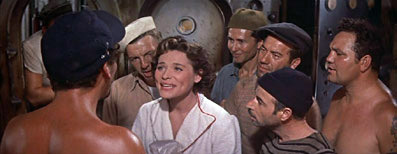|
No-one
could play cynical self-interest quite like Richard Widmark,
and if his Oscar-nominated debut role as Tommy Udo in the
1947 Kiss of Death is anything to go by,
no-one could play nasty quite like him either. It's these memorable
Widmark traits that created the only real blot on the otherwise
thrilling copybook of Michael Crichton's 1978 medical thriller
Coma. Casting Widmark as the chief surgeon
and then expecting an audience not to realise he's the bad
guy is frankly asking too much. It's a fine performance,
but from the moment he appears there might as well be a
huge red sign above his head saying "Do not trust this
man!" But
let's stick to cynical for now, and if you want to see Widmark
do this one to perfection then I urge you to hunt out Samuel
Fuller's gripping 1953 Pickup on South Street.
In it, Widmark plays a pickpocket who by chance lifts a stolen
microfilm that's on its way to enemy hands and, ignoring
appeals to his patriotism, kicks off a bidding war between
the US authorities and their Communist foes.
Directed
by Fuller the following year, Hell and High Water
again stars Widmark as a cynic in a cold war climate. Here
he plays ex-submarine captain turned mercenary Adam Jones,
who's hired by a privately financed international group
to transport two of their number – French nuclear scientist
Professor Montel (Victor Francen) and his beautiful assistant
Denise Gerard (Bella Darvi) – to an Alaskan island to investigate
possible communist evil dealings.
You don't have to be too
sharp-eyed to spot the signs that this is more adventure
yarn than political thriller, the most obvious being Miss
Gerard herself. Not only is she devilishly good looking,
she's smart as a button, can fluently speak and read every
language she encounters and is completely committed
to her cause. None of which stops Jones's hand-picked crew
from falling over themselves to impress her, or Jones himself
from snogging her when the going gets tough.

Hell
and High Water retreads some ground from Fuller's 1951
Fixed Bayonets!
in the moral awakening of its central character, but the
politics that were largely irrelevant to the earlier film
are brought more bluntly to the fore here. From a modern
perspective, the reading seems clear, with the well-meaning
but ultimately ineffectual multi-national group being representative
of the United Nations – or at least a common American view
of it – a body that investigates but even in the face of
international catastrophe refuses to take military action,
something that is left to the bullish American naval commander
to initiate. The final act could even be read as a shout
for the UN and apolitical Americans to wake up and get with
the programme, to realise that the Reds are out there and
that they're plotting against us and that the free world needs
to get off it's ass and damned well do something to stop
them. All of which comes across as both simplistic and a little
crude, not helped by a music score that hits heroic heights
worthy of John Phillip Sousa, giving a couple of scenes
an unfortunate twinge of Doc Savage parody.
Where
the film does score is in the character detail and the handling
of specific scenes, a highlight being the stand-off with
a Chinese sub in a waiting game that gradually robs the
crew of air, a tense and memorable sequence with a somewhat
unlikely conclusion. The crew camaraderie is a typical Fuller
strong point and he appears to delight in their multiculturalism,
with subtitle-free exchanges held in a number of languages
and a self-sacrificing Chinese crew member included
to help paint the enemy in ideological rather than racial colours.
The
action is inevitably well handled, with a vigorous land-based
gun battle in which the bullet traces are visible, and a
striking image of crew members paddling through a sea of
fire, and there are a couple of tough character moments
that remind you just who is in the director's chair. But
despite these genuine pleasures, Hell and High Water
can't help but feel like a lesser early Fuller work whose
cheerful wandering down the Boy's Own Adventure path
detracts from its both credibility and excitement value.
Nontheless, inconsistent and intermittent though the high
points may be, there are just enough to fire the interest
of Fuller devotees, while undemanding war movie fans, particularly
those with a thing for submarine adventures, should find
plenty here to keep them happy.
Shot
in CinemaScope, as the accompanying trailer repeatedly reminds
you, the aspect ratio is an accurate 2.55:1 and the picture
is anamorphically enhanced. The print and transfer quality
are generally good, although there is some brightness flickering
in places and the black levels take on a blue tinge in some
of the darker scenes. Largely dust and damage free, the
transfer is sharp and the contrast in the brighter scenes
is very good.

The
stereo 2.0 track has clear separation and is generally very
serviceable, although a slight hiss can be detected behind
the dialogue on the quieter scenes, something that is likely
down to the original sound recording (it cuts of immediately
at the conclusion of each line). What is missing here is
the original 4-track stereo soundtrack, which is included
on Fox's US DVD release.
Trailer
(2:23)
If you need any reminding that Hell and High Water was shot in CinemaScope then tune in here and you'll have
it yelled at you repeatedly by the film trailer equivalent
of an American market barker. It is, he assures us, "the
modern miracle you can see without special glasses!"
How about that!
A
Sam Fuller version of a crowd-pleaser, Hell and
High Water nonetheless has just enough memorable
Fuller detail to make it one for the collection if you're
a fan. Optimum's UK disc loses out to Fox's US release on
soundtrack options and extra features, but otherwise showcases
the film rather well.
|